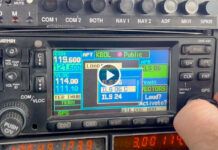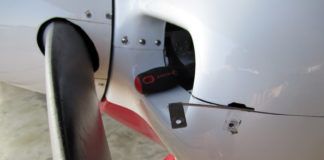You could blame a lack of competition for Garmin easing off the development accelerator pedal. After all, the GPSMAP 396-the first to offer XM-carried weather in an all-in-one GPS-was released at Oshkosh 2006, and the 496 followed a year later. This year, nothing new from Garmin-though we did hear rumors centering on a big, touch-screen upgrade from the versatile -96 lineup-as tablet-computer-based solutions started to become more popular.
Well, someone in Olathe hit the passing gear, and the result is the GPSMAP 696. Garmins new box blurs the line between a permanently mounted multifunction display (MFD) and a portable GPS. It is extraordinarily feature packed. The powerful GPS, slick graphics, satellite weather and music, voice alerts, terrain, comprehensive database and flexible outputs are expected-but there’s a lot more.
Big Inside, Big Outside
No question the 696 is big boned. The case measures 5.7 inches wide by 7.7 tall (and 2 inches thick), framing a 7-inch-diagonal screen. It literally dwarfs the 496. At 2.2 pounds, its going to feel like a brick strapped to your leg, so good thing we Experimental types can hard mount the thing. Garmin ships a RAM yoke mount, but I bolted it right to the panel by using the four 6-32 threaded inserts intended to mate with the RAM mount. They’re in a square layout about two thirds of the way up the back.
Plan on using ships power, too; with the backlight running full blast and the XM puck powered up, the internal battery is good for just more than 2 hours, less than half a 496s duration. You might pass up using an external antenna, though; the 696s GPS engine is incredibly sensitive. For example, my Garmin 496 never sees satellites when its in the hangar, even with the external antenna. The 696 locked on almost immediately, and worked perfectly well with the internal antenna over hours of flying in a high-wing airplane. It also has a fast processor. The only time I noticed it taking time to redraw a screen was when it had a ton of information on it. Impressive.
But more superlative is the change in physical buttonology. The multifunction knob makes the 496s rocker pad seem primitive. As with the -96 series, you get a dedicated range controller, ENT, CLR, MENU, direct-to and NRST keys arranged vertically. Rather than bury flight plans in the menu system, the 696 has a dedicated FLP key. Five contextual buttons run along the bottom. Normally, the multifunction knob controls what you see, annunciated by a menu at the lower right corner. In this way, the 696 is more like a GNS430. The map page is at the left, and you just twist the knob right to get waypoint information, weather, terrain, XM and general information pages. Its all intuitive and as simple as it can be given the vast amount of information at your disposal.
Weather All Around You
New weather products include an icing forecast and pilot reports (PIREPS). Overall, Garmin has improved the function of the weather sub menu, in particular by fixing a feature of the 496 that made it difficult to highlight, say, an AIRMET among the other data on the screen. A new Pan menu allows you to move around on the screen and get the next level of detail easily. As before, two tiers of weather service are available, at $29.95 and $49.95 a month.
Your IFR Friend
Weather is expected in Garmin’s top-line portables, but tools for the IFR pilot might not be. Here, they include a full database of low- and high-altitude en route charts as well as NACO-sourced approach plates including airport diagrams, DPs and STARs. The 696 can legally replace a bag full of paper charts; updates are $95 each or $395 for a year subscription for the U.S. (A complete set of paper charts will cost you more than $270 each cycle.) The Jeppesen-provided airport database updates are $49.95 each or $295 for a year. Terrain, obstacle and AOPA databases are updated separately.
Garmin has masterfully integrated the IFR components. When you select an approach at your destination, the 696 automatically pulls up the NACO chart in the WPT view. Even so, that chart is not geo referenced-that is, you wont see an airplane flying on the chart-and the under-scale size of the chart makes it significantly more difficult to read than the paper item. (Charts can be zoomed in on and panned easily.) Understand, also, that the 696 is not itself IFR approved; it is acting as an assistant to your installed gear, not as a sole-source navigator.
Worth the Dough?
Garmin has pushed the limits of a portable navigator in size-price, too. The fully featured 696 retails for $3595 (street price at press time of $3295), while the non-weather 695 is $2895 (street of $2695). Call that a $900 difference from the weather-shod 496, and $1100 up comparing the non-weather 695 to the 495. The new box will also pose some mounting challenges in flying aircraft, but, once overcome, is absolutely worth the effort for the combination of the three-times-larger screen, improved operating logic and additional features. From the perspective of capability, Garmin, with the 696, has left its competition eating dust.
For more information, visit www.garmin.com/aviation. Garmin products are widely available.













